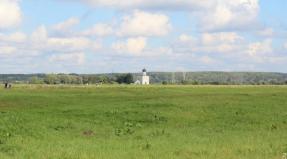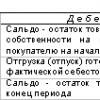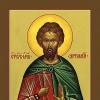Church on the Nerl River. Description of the Church of the Intercession on the Nerl: history of creation. Appearance. Mysterious ornaments of white stone carvings
Hello, dear readers!
Today I will tell you about the Temple, which is considered the most beautiful temple among thousands of churches in Russia. I’ll tell you why it’s so beautiful, where it is and how to get to it. The photographs presented here were taken during my trip " - Bogolyubovo - " August 25, 2012
This Temple is called the Church of the Intercession on the Nerl.
This small, elegant temple stands on a water meadow at the place where the Nerl flows into the Klyazma. It is located not far from Vladimir, one and a half kilometers from Bogolyubov. In spring, these places are flooded with water and it becomes impossible to get here. Well, if only by boat or helicopter.
In Bogolyubovo, immediately after the monastery, turn right and move to the railway station. From here we will go on foot. We walk along the passage over the railway tracks to the other side. The stairs, I tell you, are not weak. I tested it myself. Yes, even if with a stroller. For those who save energy (and it’s better to save it, the path is not short), there are elevators. Photos of elevators and transitions are sent to the end of the article. This is not the main thing in our journey, but it is essential. Because at the beginning we were on an enthusiastic note and didn’t even see the elevators.
Crossed the crossing. There are several trays with souvenirs, scarves, etc. products. The prices are quite normal. You can do some shopping on the way back.
A look ahead - and here it is our goal, a wonderful miracle, a white stone temple in the distance, and around a huge green meadow. Freedom!!!

The distance is not close. There are two options to get there: on foot along the path or in an open carriage drawn by a horse. Of course, we chose the first option. The road to the Temple should be like this - not simple and fast, but heartfelt and unhurried...


They passed the carts and moved forward. By the way, such a lovely path was made quite recently. Even 5 years ago, people walked to the Church of the Intercession on the Nerl along off-road roads.

Bogolyubovsky meadow, on which the Temple stands, is also a very remarkable place. On the sign that stands here near the path, it is written: “Bogolyubovsky meadow covers an area of 153 hectares. It is located in the floodplain of the Klyazma and Nerl rivers. It is unique for its forbs - more than 200 species of herbaceous plants grow here. This feature was first identified in the 60s 20 century as a result of research conducted under the leadership of Voronezh State Pedagogical University professor Nikolai Yaroshenko. Among them are species protected in the Vladimir region: Siberian iris, snow-white water lily, etc."


And here it is, the Temple.

The church stands on a hill. The hill is artificial - in its thickness there is a complex foundation 5.3 m high. The foundation was created by architects in order to protect the Temple from spring floods. Brilliant solution.
If you come here in the spring in March, April or even early May, you will find this picture:


This time we saw the Temple like this:

Once upon a time the hill was lined with white stone and there was a gallery around the Temple. Look at the photo of the reconstruction of N.N. Voronina.

It is believed that the ideal point from which the most beautiful photographs are taken is this one (see below). When photographed from this place, the Temple appears in all its glory, reflected in the water of the lake. But by the end of summer the lake became shallow and overgrown. The church is only partially reflected in the water. But that didn’t stop us from admiring her perfection.

So what is the phenomenon of the Church of the Intercession on the Nerl? And the phenomenon is a combination of man-made and natural - ideal proportions, the elegance of the Temple itself, its white stone carvings, lines and the surrounding nature. Silence, tranquility, privacy only emphasize the beauty and uniqueness of this place.


The Church of the Intercession on the Nerl was built in a few months in 1165. Prince Andrei Bogolyubsky ordered the construction of the Temple in honor of the victory over Volga Bulgaria and in memory of his beloved son Izyaslav, who died in this campaign. The temple became the first church in Rus' dedicated to the new feast of the Intercession of the Blessed Virgin Mary.
Below in the photo you see the figure of the biblical king Davila with a psalter in his hand - an ancient musical instrument. Around him are animals and birds - lions, doves, deer, enchanted by his play, as well as griffins - mythical characters. Such a plot can be found on all three facades of the church.


Next to the church there is such a technical building. There are toilets behind it.

A little more about wall carvings. On the walls above the windows there is also a row of female masks, each of which depicts a certain image: kindness and anger, pride and naivety, arrogance and gullibility.



The Church of the Intercession on the Nerl is a typical example of the Vladimir-Suzdal school of white stone architecture. This is a small one-domed four-pillar church. All its vertical details are designed to emphasize its lightness, grace and harmony. She, like a candle, is directed upward. The height of the Temple is 20 meters.

The walls of the temple are very thick - about 1 meter. The inside of the church is very small. She seemed just tiny to me. There is a Church Shop in the church.


This is the Miracle that architects built almost a thousand years ago... And it stands there, striking the imagination, delighting the soul. It is difficult to find words to express everything that I felt when I saw this Temple and was next to it. And you can’t say it better than what Archbishop Evlogy of Vladimir and Suzdal said about the Church of the Intercession on the Nerl:


We went back by cart. There is almost no strength left. This pleasure costs 150 rubles. per person. They took 50 rubles from our little man. They didn’t charge anything for our princess’s “carriage.” The four of us, plus the baby plus the stroller, piled up and rushed off.

We're going, going, going. Coos are grazing in the meadow... That's right, cows!


This is how our journey to the Temple of the Intercession on the Nerl ended... As souvenirs, we bought magnets, bells, as well as a pipe and a rattle for our little traveler. But our adventures didn’t end there that day - we went to. But more on that next time.
And lastly, as promised, a photo from the crossing to the Bogolyubsky Monastery, a photo of the crossing over the railway tracks and a photo of the elevator at the station. I think that on the way back you will definitely use his services.





The Church of the Intercession on the Nerl is called a masterpiece of world architecture; the pinnacle of creativity of Vladimir masters from the heyday of the Vladimir-Suzdal principality. This small, elegant building is located on a small hill, in a riverine meadow, where the Nerl flows into the Klyazma.
It happened that during the spring flood, the water approached the very walls of the church, and then a light, one-domed temple, dazzlingly sparkling with white, rose alone above the water surface, like a candle, growing over the expanses of flooded meadows in all its clarity and beauty...

In all of Russian architecture, which has created so many unsurpassed masterpieces, there is probably no more lyrical monument than the world-famous Church of the Intercession on the Nerl.

This amazingly harmonious white stone temple, organically merging with the surrounding landscape, is called a poem captured in stone. “The ideal consistency of the general and the particular, the whole and the smallest details creates a subtle and enlightened harmony, likening the architecture to spiritual and soaring music or a song,” writes N.N. Voronin. “The image of the famous creation of the Vladimir masters is so perfect that there was never any doubt about that this is how it was originally, that this is how it was intended by its architects.”

Tradition tells that Prince Andrei Bogolyubsky built the Church of the Intercession on the Nerl after the death of his beloved son Izyaslav - in memory of him. This is probably why this church, solitary on the banks of the Nerl, emanates a light sadness.

The Church of the Intercession on the Nerl is compared to ancient Greek temples in its brevity and perfection of forms. Looking at this amazing creation of Russian masters, it is difficult to believe that the Church of the Intercession on the Nerl was only miraculously saved from destruction. And he was in danger not from the militant atheists of the communist era, but from the Orthodox clergy. In 1784, the abbot of the Bogolyubov Monastery petitioned the diocesan authorities for permission to dismantle the Church of the Intercession on the Nerl in order to use its material to build the monastery bell tower. The Bishop of Vladimir gave such permission. The church survived only because customers and contractors did not agree on the price.

The Church of the Intercession on the Nerl was built in 1165. Historical sources connect its construction with the victorious campaign of the Vladimir regiments against Volga Bulgaria in 1164. It was on this campaign that the young Prince Izyaslav died. In memory of these events, Andrei Bogolyubsky founded the Intercession Church. According to some news, the white stone for the construction of the church was delivered as an indemnity by the defeated Volga Bulgars themselves.

The temple was dedicated to a new holiday in Rus' - the Intercession of the Virgin Mary. This holiday was established by the Vladimir clergy and prince without the consent of the Kyiv Metropolitan and the Patriarch of Constantinople and was intended to testify to the special patronage of the Mother of God for the Vladimir land. After all, the main temple of Vladimir, the Assumption Cathedral, was also dedicated to the Mother of God - unlike the cathedrals of Kyiv, Novgorod, Polotsk, Pskov and other princely capitals.

The location for the church - a floodplain meadow at the confluence of the Nerl and the Klyazma - was indicated by Prince Andrei Bogolyubsky himself. Since there was widespread flooding here every spring, a high foundation was built especially for the temple - an artificial hill made of clay and cobblestone, in which the foundations of the future building were laid. The outside of this hill was lined with white stone slabs. When the Nerl floods in the spring, the church remains on a small island, reflected in the fast-flowing waters that approach its walls. Once upon a time there was a pier where river ships sailing along the Klyazma moored.

Structurally, the Church of the Intercession on the Nerl is extremely simple - it is a single-domed, cross-domed, four-pillar temple, typical for ancient Russian architecture. But the builders of the church managed to embody a completely new artistic image in it. The Church of the Intercession on the Nerl differs from earlier Vladimir churches in its refined proportions, extreme clarity and simplicity of composition. There is no royalty here of the Vladimir Assumption Cathedral, there is no courageous majesty of the Demetrius Cathedral. Light and light, the Church of the Intercession on the Nerl is the embodiment of the victory of spirit over matter. With the help of well-chosen proportions, shapes and details, the architects managed to overcome the heaviness of the stone, creating the impression of weightlessness and upward striving.

Using all available techniques, the unknown architects tried to give their building a sense of movement. This is achieved to a large extent by the calm balance and symmetry of the building, as well as many original construction finds. For example, it is almost impossible to notice that the walls of the church are slightly tilted inward and this barely noticeable tilt visually increases the height of the building. The same purpose is served by a large number of conspicuous vertical lines - elongated columns of the arcature belt, narrow high windows, and an elongated drum of the dome. The existing onion dome replaced the ancient helmet-shaped dome in 1803.

The walls of the temple are decorated with white stone carvings, traditional for Vladimir-Suzdal architecture. The same composition is repeated on all three facades: King David the psalmist sitting on the throne. On both sides of it, two doves are symmetrically located, and below them are figures of lions. Even lower are three women's masks with their hair braided. The same masks are placed on the side parts of the facade - the temple seems to be surrounded by them. These masks symbolize the Mother of God and are present on all Vladimir churches of that era.


Archaeological excavations have revealed that initially the temple was surrounded on three sides by an open white-stone gallery paved with bright majolica tiles. In the southwest corner of the gallery there was a staircase leading to the choir. The gallery rested on carved white stone pillars, and its parapet was decorated with numerous carved stones depicting griffins and other mythical animals. Among them, images of leopards rising in a jump stood out - the emblem of the Vladimir princely dynasty.

The interior space of the church is subject to the same idea - upward movement. The four pillars on which the vaults rest slightly narrow at the top, thereby visually increasing the height of the temple. A dome full of light hovers high above your head. Once it housed an image of Christ the Pantocrator, surrounded by archangels and seraphim, and the walls of the temple were covered with a motley carpet of frescoes, which was echoed by a colored majolica floor. The ancient painting, damaged over seven centuries, was finally destroyed in 1877 during the next “renovation” of the temple.


But, despite all the losses, the Church of the Intercession on the Nerl retained the main thing that the unknown architects who created it strived for - the idea of the superiority of the spiritual over the material, brilliantly expressed in stone, which is the cornerstone of any religion. And, probably, that is why this outstanding work of Russian masters received worldwide fame and recognition, becoming a kind of “calling card” of Russia.

Church of the Intercession on the Nerl.
A white stone temple in the Vladimir region of Russia, one and a half kilometers from Bogolyubov, an outstanding monument of architecture of the Vladimir-Suzdal school.
The church was consecrated in honor of the Feast of the Intercession of the Virgin Mary, established in Rus' in the middle of the 12th century.
The Church of the Intercession stands in a lowland, on a water meadow. Previously, near the church there was a place where the Nerl flows into the Klyazma (now the river beds have changed their position). The church was located practically on the river “spit”, forming a crossroads of the most important water trade routes.
The Church of the Intercession was built on a man-made hill. The usual strip foundation, laid at a depth of 1.6 m, is continued by the base of the walls, 3.7 m high, which were covered with clay soil of an embankment, lined with white stone. Thus, the foundation went to a depth of more than five meters. This technology made it possible to resist rising water during river floods (up to 5 m).

From the 12th century temple, the main volume has been preserved to this day without significant distortion - a small, slightly elongated along the longitudinal axis (about 8 x 7 m excluding apses, the side of the dome square is about 3.2 m) quadrangle and dome. The temple is of the cross-domed type, four-pillared, three-apsed, single-domed, with arched-columnar belts and perspective portals. The walls of the church are strictly vertical, but thanks to the exceptionally well-found proportions, they look inclined inward, which achieves the illusion of a greater height of the structure. In the interior, the cross-shaped pillars taper towards the top, which, given the small size of the temple, creates an additional feeling of “height” in the interior.



The walls of the church are decorated with carved reliefs. The central figure in the composition of the three facades of the temple is King David seated on the throne with a psalter (a stringed musical instrument) in his left hand, blessing with two fingers with his right hand. Also used in the design are lions, birds and women's masks.
The original interior paintings of the temple were completely lost (they were knocked down during renovation in 1877).
The meadow on which the church is located is now a specially protected natural area and declared a historical and landscape complex of regional significance. The Church of the Intercession on the Nerl itself is included in the UNESCO World Heritage Site called “White Stone Monuments of Vladimir and Suzdal”.
Currently, the temple is jointly managed by the Russian Orthodox Church and the Vladimir-Suzdal Museum-Reserve. Regular services are held in the temple; the rest of the time it is open as a museum exhibition.



Article from the book "The Most Famous Monasteries and Temples of Russia"
source
One and a half kilometers to the nearest fortified town of Bogolyubov. Pilgrims walk on foot through water meadows and off-road to see the walls that still remember the Tatar-Mongol yoke. According to legend, the Church of the Intercession of the Virgin Mary was built in honor of the victory of Prince Andrei Bogolyubsky over the Bulgars in the mid-12th century. The life of the prince also reports that this temple is a tribute to the memory of Izyaslav Andreevich, the son of the Grand Duke. Izyaslav died from wounds received during a military campaign.
The prince chose the place for the temple in the flooded meadows, at the crossroads of two rivers - the Nerl and Klyazma. Before construction, it was necessary to build a hill of stones held together with clay as protection from spring waters. History has not preserved the names of the architects, but the craftsmen were skilled: they began to build the walls at a depth of five meters and decorated the temple with stone slabs. So even in the deepest flood, the basements do not flood. This allowed the church to stand for eight centuries.
“The ideal consistency of the general and the particular, the whole and the smallest details creates a subtle and enlightened harmony, likening architecture to spiritual and soaring music or song”, writes one of the leading experts on ancient Russian architecture, Nikolai Voronin. “The image of the famous creation of the Vladimir masters is so perfect that there was never any doubt that this was how it was originally, that this is how it was intended by its architects.”.
The Church on the Nerl is the first in Russia consecrated in honor of the Feast of the Intercession of the Blessed Virgin Mary. Shortly before the construction of the church, the priests and the prince himself adopted this spiritual holiday as a sign of the special mercy of the Blessed Virgin to the land of Vladimir. The main temple of Vladimir is also dedicated to the Mother of God - unlike Kyiv, Novgorod, Pskov, Polotsk and other princely capitals.
The frescoes that decorated the walls of the Church of the Intercession on the Nerl depicted King David on the throne. At his feet are lions and griffins, and doves soar around. Three female faces on the frescoes, as in all Vladimir churches, symbolize the Mother of God.
In the 18th century, the church barely withstood the onslaught of time. The roof almost crumbled, the dome almost collapsed, and the carved bas-reliefs were also damaged. By 1784, the temple had fallen into such a deplorable state that the abbot of the Bogolyubov Monastery asked the diocese for permission to dismantle the church and use the stone for a new bell tower. The white stone miracle survived for worldly reasons: the workers demanded such a high price that they decided to leave the temple and even restored it.
In the mid-twentieth century, archaeological excavations were carried out around the church. Scientists have discovered the remains of an ancient foundation. It is believed that this is part of a gallery that once surrounded the temple on three sides. Fragments of figures of animals and birds carved from white stone also survived.
UNESCO heritage
The Church of the Intercession on the Nerl is an architectural masterpiece recognized throughout the world. Since 1992, as part of the “White Stone Monuments of Vladimir and Suzdal”, the temple has been included in the UNESCO World Heritage List. Among the eight majestic monuments of ancient architecture of the Vladimir-Suzdal school, this is the most poetic. A white church, surrounded by green meadows, directed with a strict dome towards the blue sky... A poem imprinted in stone.
The Church of the Intercession on the Nerl, a photo of which you will find in this article, is small, but very old and beautiful.
It was built back in the days of Kievan Rus and survived during fires, princely wars, and the Mongol-Tatar invasion. Even the Soviet government did not dare to destroy this amazing structure.
Once upon a time, the temple was the center of a large monastery and served as a kind of “arrow” on the waterways of Russia. Now it stands modestly in the middle of a deserted water meadow. But even without the majestic surroundings and gilding, the architectural monument is beautiful in its own way. The structure alone pleases the eye of both the tired traveler and the righteous pilgrim. For the artist Sergei Gerasimov, she served as a source of inspiration for creating a painting - the author immortalized her image in the canvas “Church of the Intercession on the Nerl”.
The white-stone beauty not only has the status of a cultural monument - since 1992 it has been included in the list of UNESCO World Heritage Sites. Even Bogolyubsky Meadow, on which the church is located, has been declared a specially protected natural area and a historical and landscape complex of regional significance.
It is this masterpiece of Vladimir-Suzdal architecture that our story will be about.
In contact with
Location and address
The Church of the Intercession is located in the village of Bogolyubovo, Suzdal region. The temple rises on the banks of the Nerl River, at its confluence with the Klyazma. To get to the structure, you need to drive through Vladimir by car or by commuter train to the Bogolyubovo station.

Location of the Church of the Intercession on the Nerl
From Moscow you can do this along the M7 highway “Moscow – Vladimir – Ufa”. From the station, as well as from the railway bridge over the Nerl River, dirt roads lead to the temple.
Take into account: The meadow on which the architectural monument is located has been declared a protected area. Car traffic is prohibited on it. You can get from the railway station to the temple on foot or by horse-drawn cart. Distance from the station – 900 meters.
Brief historical background
The history of the temple is shrouded in mystery, because the chronicle evidence about it is very meager - the architect of the temple is unknown. There is also no information about the exact date of construction of the temple. Almost nothing is also known about who the craftsmen were, whose hands the building was erected; the chronicles only briefly say that “masters from all lands” worked on it.
And an interesting fact is also connected with the stone from which the Church of the Intercession was built: Wikipedia says that “according to the legend contained in the Life of Andrei Bogolyubsky, the white stone for the construction of the church was taken from the Bulgarian kingdom conquered by Andrei Bogolyubsky. However, this legend is refuted both by historical facts and by the results of petrographic analyzes of the white stone used to build the church.”
According to various historians, the Church of the Intercession on the Nerl was founded in 1158 or 1165. Craftsmen from many lands of Rus', as well as from abroad, took part in the construction of the temple. In particular, some craftsmen were sent by the King of Germany, Frederick Barbarossa. The order for the construction of the structure was given by Grand Duke Vladimir Bogolyubsky.

The traditional dating of the temple according to N.N. Voronin is 1165, based on the message from the Life of Andrei Bogolyubsky that the Church of the Intercession on the Nerl was built in memory of the deceased son of the Grand Duke Izyaslav Andreevich
Initially, the church was built as a cathedral, the center of a large monastery. The location of the monastery in which the temple was built in those days was at the junction of trade routes. Covered walking galleries and utility buildings were built near the temple. All of them were destroyed in the XIV-XVI centuries, and dismantled in the XVII-XVIII centuries. In the 18th-19th centuries, several renovations of the structure were carried out. During one of them, in 1877, the original paintings on the walls and dome were lost.
In 1761, next to the Church of the Intercession, the winter church of the Three Saints was erected. In 1884 it was rebuilt from wood to stone. Since 1923, the church was closed by the Bolsheviks. In 1980-1985, its complete restoration was carried out using budget funds. In 1991, the temple was transferred to the Orthodox Bogolyubsky Monastery, and in 1992 documents were prepared to include the monument on the UNESCO heritage list.
Description and architectural features
The location of the Church of the Intercession on the Nerl is unique for ancient Russian churches. It stands in a lowland, on a hill only 6 meters high, although most religious buildings in the Middle Ages were built on hills.

The walls of the church are strictly vertical, but thanks to the exceptionally well-found proportions, they look inclined inward, which achieves the illusion of a greater height of the structure
This is interesting: The foundation of the chapel is made of untreated stones filled with lime. Its total depth exceeds 5 meters. Such a powerful foundation was made so that the structure could stand even during spring floods, when the level of the Klyazma and Nerl rivers rises by more than 3 meters.
The continuation is the walls, decorated with bas-reliefs, with images of King David the psalmist, lions and griffins. The walls are also decorated with pilasters with half-columns. Inside the temple they correspond to small projections.

Architectural plan of the Church of the Intercession
In plan, the structure is a square with a side of 10 meters. The space under the dome of the temple is also a square with sides 3.2 meters long. Architecturally, the church belongs to Byzantine type buildings. Inside, 4 pillars divide it into 9 cells. The columns and walls taper towards the top and give the impression of the great height of the temple.
It is worth noting: Because of its precise proportions and beautiful appearance, the Church of the Intercession on the Nerl is considered by many researchers and ordinary people to be the most beautiful religious building in Russia.
State of the Church Today
The temple on the Nerl is now shared by the Russian Orthodox Church and the Vladimir-Suzdal Museum-Reserve. In relation to the latter, the building is part of the Mother of God Nativity Monastery.

Unfortunately, the original interior paintings of the temple were completely lost (they were knocked down during renovation in 1877)
Externally, the church is well preserved. The walls are regularly plastered and tinted by the monks and museum staff. The interior decoration is decorated with several icons and candlesticks. The walls are left empty.
Note: The chapel is open daily, but services are held only on Sundays and Christian holidays. There are 3 monks living at the monastery courtyard who conduct all religious rituals.
Archaeological excavations
On September 29, 1882, archaeological excavations began in the church and on its territory. Historians have found the tombs of the sons of princes Andrei Bogolyubsky and Daniil Alexandrovich Izyaslav and Boris. Also discovered were the foundations of covered galleries, gutters and the white stone pavement that covered the temple hill. The second time excavations took place in the middle of the last century. During their investigation, additional details of the temple complex were discovered.

Reconstruction of the Church of the Intercession on the Nerl according to N.N. Voronin
Based on the results of the discoveries, archaeologist N.N. Voronin drew up a plan of all the structures that surrounded the chapel, and made several drawings of the general view of the structure.
The latest archaeological studies of the temple were carried out in 2004-2006. During their implementation, it was possible to stop soil degradation near the church and block access of illegal tourists to the structure.
Amazing facts about the Church of the Intercession
According to legends, it is believed that the church was named in honor of the Feast of the Intercession of the Blessed Virgin Mary. But modern historians claim that this day (October 14) began to be celebrated only 200 years after the construction of the temple. Accordingly, the chapel was dedicated not to the holiday, but to the Virgin Mary herself.

However, some scientists put forward the hypothesis of the dedication of the temple to the Savior and the Blessed Virgin Mary, associated with the miracle that happened to Andrei Bogolyubsky. During the battle with the Volga Bulgarians on August 1, 1164, when dazzling rays began to emanate from the icons of the Savior and the Mother of God. The Russians, thanks to the intercession of the Mother of God, defeated the foreigners.
Also, according to one of the legends, for the construction of the buildings of the complex, white stone was used, which was taken out from the Bulgarian kingdom conquered by Prince Andrei Bogolyubsky. But modern studies of the mineralogical composition of the walls and foundation of the structure have shown that the material for them was stone from the outskirts of Vladimir.
The beauty of the natural world around
The Nerl and Klyazma rivers flow next to the Church of the Intercession on the Nerl. Behind the temple there is a small pond, which becomes shallow in the summer and fills with water in the spring. It is from the side of this reservoir that the most picturesque view of the architectural monument opens.

Bogolyubovsky meadow near the church
Interesting fact: More than 290 species of plants were discovered in the reserved meadow near the church. 4 of them are listed in the Red Book of the Vladimir region. Sometimes white-tailed eagles, birds of prey that belong to the hawk family, land near the temple.
The total area of untouched territory near the chapel is 76.5 hectares. The flat, table-like terrain next to a quiet, flat river creates a feeling of calm and peace of mind. The church, which rises on a small hillock, resembles a white-skinned maiden, and the trees surrounding her make up the beauty's wreath and decorations.
Pilgrimage
A visit to the structure is included in 90% of excursions around Vladimir and the Golden Ring of Russia. Pilgrimage trips to the Church of the Intercession on the Nerl are carried out under the guidance of pilgrimage services of churches in Moscow, Yaroslavl, and Nizhny Novgorod.

The Church of the Intercession on the Nerl is open to everyone



















